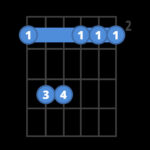Have you ever seen those ads promising to teach you guitar in minutes? It might sound too good to be true, and while mastering guitar takes time, learning a simple song quickly is absolutely achievable. However, simply mimicking chords won’t build a lasting understanding of music. It’s crucial to grasp the “why” behind the “how” to truly progress as a guitarist.
This lesson, the first in our “Easy Songs for Beginners” series on guitarplayers.net, aims to do exactly that. We’ll learn to play the iconic song “A Horse With No Name” and explore the musical concepts within it. Beyond just playing the chords, we’ll delve into strumming variations, a basic bass line, and even touch upon rhythm riffs and lead fills in our follow-up lesson. Get ready to learn and have fun!
The Bare Essentials: Two Simple Chords
Imagine you’re brand new to guitar. Can you still learn this song? Absolutely! We’ll start with the absolute basics. I’m going to assume you’ve at least held a guitar before and know some basic guitar terms. If not, quickly check out our Absolute Beginners Chords lesson. Focus on the E minor chord – you’ll need it for this lesson!
The song we’re tackling is “Horse With No Name,” a classic by the band America, written by Dewey Bunnell. Remarkably, the entire song is built around just two chords. You already know one (E minor), and the second, while having a fancy name, is also quite easy to play.
The E minor (Em) chord is indeed beginner-friendly. For the second chord, often called Dadd6add9, it’s said that Dewey Bunnell might have stumbled upon it by accident or while exploring the fretboard. Regardless of its origin, it sounds great!
Both chords are easy to finger. For Em, you place your second finger on the 2nd fret of the A string (5th string) and your third finger on the 2nd fret of the D string (4th string). To transition to the Dadd6add9, simply shift those two fingers outwards to the next strings: second finger to the 2nd fret of the low E string (6th string) and third finger to the 2nd fret of the G string (3rd string). Think of it as a mini “jumping jacks” exercise for your fingers!
(We’ll dive deeper into the “Dadd6add9” name later in the “What is that chord really?” section.)
The song’s rhythm is in 4/4 time, meaning four beats per measure, and the chords change every measure. Start with a simple downstroke strum. You can strum on every beat (1, 2, 3, 4) or try a slight variation by strumming on beats 1, 2, and 4. “Horse With No Name” has a moderate tempo – not too fast, not too slow. When learning, prioritize smooth chord changes while maintaining a steady beat, even if it means playing slowly. A metronome can be a valuable tool here.
Here’s a basic chord chart to get you started with the verses and chorus:
 Horse With No Name America chords and lyrics cheat sheet
Horse With No Name America chords and lyrics cheat sheet
Simple enough, right? Let’s move on and add some flavor to your playing.
Adding Strumming Patterns and Rhythm
Once you can confidently switch between Em and Dadd6add9, the next step is to focus on strumming. While chord changes are minimal in this song, mastering rhythm is crucial for any guitarist. It’s not just about hitting the strings; it’s about creating rhythmic patterns that enhance the song’s feel and make it more engaging to play and listen to.
You might be surprised how much difference a strumming pattern can make. The most basic strum is just downstrokes, but let’s explore something closer to the original song’s rhythm, incorporating upstrokes.
An symbol indicates strumming upwards (towards your head), and a denotes strumming downwards (towards the guitar body).
This pattern above is functional, but rhythmically basic. To get closer to the song’s groove, we need to incorporate upstrokes and think about “off-beats” or eighth notes. Instead of counting “1, 2, 3, 4,” we’ll count “1 and 2 and 3 and 4 and.” The tempo remains the same; we’re just dividing each beat in half.
Here’s an alternative strumming pattern that’s closer to the original feel:
 Horse With No Name alternate strumming pattern guitar chords Download MP3
Horse With No Name alternate strumming pattern guitar chords Download MP3
If upstrokes are new to you, start very slowly. Focus on counting “1 and 2 and 3 and 4 and” and placing each downstroke and upstroke accurately. You’ll likely find it becomes natural quickly with a bit of practice.
Adding Depth: A Simple Bass Line
Ready to add even more to your rendition? Let’s incorporate a basic bass line. It’s surprisingly easy and adds a lot of depth and texture, especially for a beginner.
The technique is simple: on the first beat of each measure, strike only the lowest string (the 6th string, low E). Combine this bass note with your strumming pattern for the rest of the measure. Here’s an example, with “D” indicating downstrokes and “U” for upstrokes:
 Horse With No Name guitar chords strumming with bass note example
Horse With No Name guitar chords strumming with bass note example
From this starting point, you can experiment further. One cool variation is to play an upstroke on the second beat of the Em chord very close to the bridge of the guitar (away from the neck). Let that chord ring out for the remaining three beats of the measure:
 Horse With No Name guitar chords ringing strumming example
Horse With No Name guitar chords ringing strumming example
You can also try fingerpicking individual strings instead of strumming. In this example, the three highest strings are picked as upstrokes on the last beat and a half of the measure:
 Horse With No Name guitar chords fingerpicking example
Horse With No Name guitar chords fingerpicking example
Once you have a few strumming and bass patterns you like, you can start mixing and matching – “Em pattern 1” with “Dadd6add9 pattern 3,” and so on. It becomes a fun way to explore the song and create your own variations.
Even simple songs like “Horse With No Name” offer rich opportunities for musical exploration if you’re willing to experiment. Or, you can stick with the basic chords and move on. The choice is yours, but hopefully, this encourages you to dive a little deeper!
What Is That Chord Really? Demystifying Dadd6add9
Let’s talk about that second chord, Dadd6add9. If we analyze the notes within this chord shape, we find:
As we discussed in our Building Additions and Suspensions lesson, this chord could have several names depending on the context and your interpretation. Bm7 (add 4)? D6 (add 9)? Even E9 (sus4) are theoretically possible names based on the notes present.
Chord naming often depends on context – how the chord functions within a song. Voicing, or how the chord is arranged on the guitar, also plays a crucial role. Let’s revisit our two chords in “Horse With No Name”:
What key is the song in? A simple approach is to notice it starts and ends on Em, suggesting E minor. Listen to how the Em chord feels like “home,” a point of resolution. The Dadd6add9, in contrast, feels more unsettled, like it wants to move somewhere. Play them in reverse order, and the Dadd6add9 still yearns for resolution.
For me, the F# in the bass of the Dadd6add9 voicing is significant. It sounds like the root of the chord in this context, more so than D, E, or A. If we build a chord starting on F# and include the notes we find in the Dadd6add9 shape (using “-” for missing notes), we get:
You can see the 5th (C#) and 9th (G#) are absent from the six notes in the chord voicing. Instead, we have an added A (the 4th or 11th). We could call it F#m13 for simplicity, or F#m7 (no 5)(add 4)(add 6) for a more detailed but cumbersome name. “Dadd6add9” is a reasonably practical and descriptive name in this case.
This brings up an interesting point: with complex chords containing 7 or more notes, and only 6 strings on a guitar, which notes do you prioritize? Often, the 5th is omitted, but sometimes even the root can be implied rather than explicitly played. The most practical answer is often determined by what’s easily playable on the fretboard. For example, strumming open strings gives you an A11 chord (E-A-D-G-B-E), missing the 3rd (C#). While you could add the 3rd, the open A11 voicing sounds complete as is. A general guideline for 9th, 11th, and 13th chords is to include the 7th and root to establish the chord’s identity.
Is this chord theory deep dive important for simply playing “Horse With No Name”? Maybe not immediately. But understanding these concepts enhances your musical knowledge and opens doors for creativity. Next time, we’ll explore how understanding the “Dadd6add9” chord identity helps us create fills and lead lines within the song’s modal framework. It’s less complicated than it sounds!
As always, feel free to ask questions or suggest topics in our Guitar Forums or email me directly at [email protected].
Until next time, keep playing!
Peace
Liner Notes
“A Horse With No Name” by America is a folk-rock classic penned by Dewey Bunnell. Its acoustic, folky style draws comparisons to Neil Young. Interestingly, in 1972, this song replaced Neil Young’s “Heart of Gold” as the #1 single in America.


